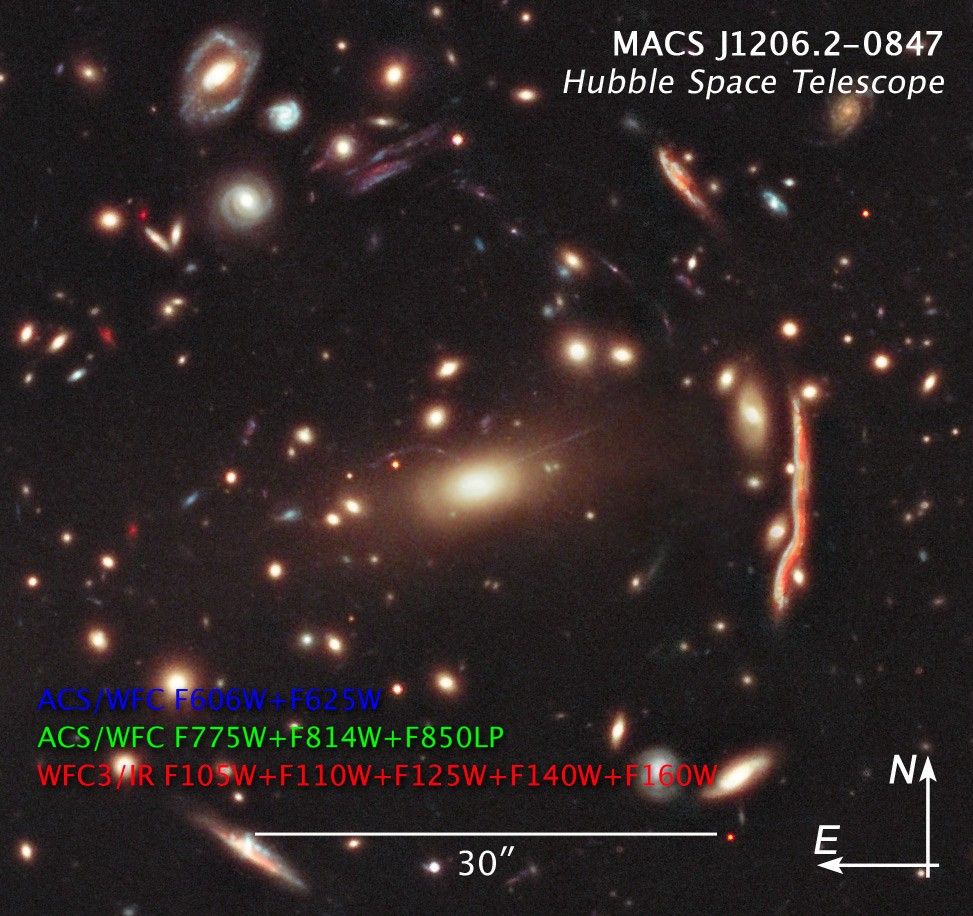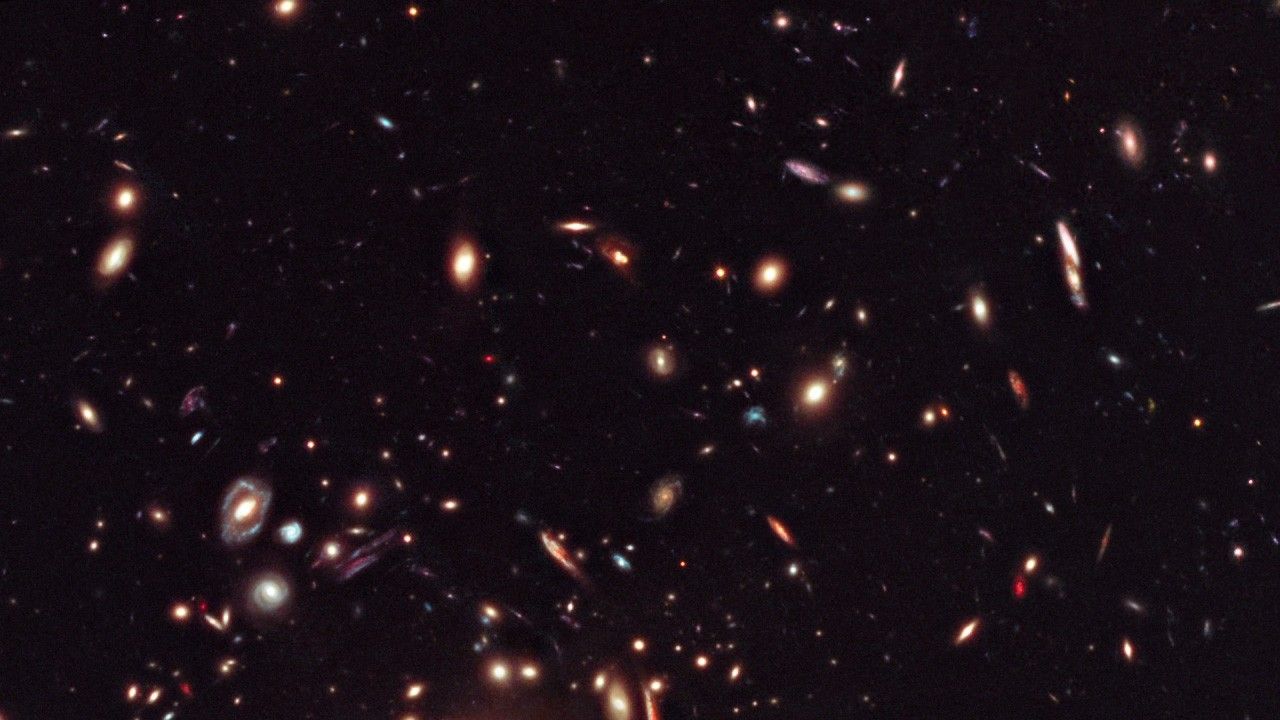1 min read
Galaxy Cluster MACS 1206

This image of galaxy cluster MACS J1206.2-0847 (or MACS 1206 for short) is part of a broad survey with NASA's Hubble Space Telescope.
The distorted shapes in the cluster are distant galaxies from which the light is bent by the gravitational pull of an invisible material called dark matter within the cluster of galaxies. This cluster is an early target in a survey that will allow astronomers to construct the most detailed dark matter maps of more galaxy clusters than ever before.
These maps are being used to test previous, but surprising, results that suggest that dark matter is more densely packed inside clusters than some models predict. This might mean that galaxy cluster assembly began earlier than commonly thought.
The multiwavelength survey, called the Cluster Lensing And Supernova survey with Hubble (CLASH), probes, with unparalleled precision, the distribution of dark matter in 25 massive clusters of galaxies. So far, the CLASH team has completed observations of six of the 25 clusters.
Dark matter makes up the bulk of the universe's mass, yet it can only be detected by measuring how its gravity tugs on visible matter and warps space like a fun-house mirror so that the light from distant objects is distorted.
Galaxy clusters like MACS 1206 are perfect laboratories for studying dark matter's gravitational effects because they are the most massive structures in the universe. Because of their heft, the clusters act like giant cosmic lenses, magnifying, distorting and bending any light that passes through them – an effect known as gravitational lensing.
Lensing effects can also produce multiple images of the same distant object, as evident in this Hubble picture. In particular, the apparent numbers and shapes of distant galaxies far beyond a galaxy cluster become distorted as the light passes through, yielding a visible measurement of how much mass is in the intervening cluster and how it is distributed. The substantial lensing distortions seen are proof that the dominant component of clusters is dark matter. The distortions would be far weaker if the clusters' gravity came only from the visible galaxies in the clusters.
MACS 1206 lies 4.5 billion light-years from Earth. Hubble's keen vision helped CLASH astronomers uncover 47 multiple images of 12 newly identified faraway galaxies. Finding so many multiple images in a cluster is a unique capability of Hubble, and the CLASH survey is optimized to find them. The new observations build on earlier work by Hubble and ground-based telescopes.
Taking advantage of two of Hubble's powerful cameras, the Advanced Camera for Surveys and the Wide Field Camera 3, the CLASH survey covers a broad wavelength range, from ultraviolet to near infrared. Astronomers need the diverse colors to estimate the distances to lensed galaxies and study them in more detail. Hubble's unique capabilities allow astronomers to estimate distances to galaxies that are four times fainter than ground-based telescopes can see.
The era when the first clusters formed is not precisely known, but is estimated to be at least 9 billion years ago and possibly as far back as 12 billion years ago. If most of the clusters in the CLASH survey are found to have excessively high accumulations of dark matter in their central cores, then it may yield new clues to the early stages in the origin of structure in the universe.
Future telescopes like NASA's James Webb Space Telescope, a space-based infrared observatory now being built, will be able to study the fainter lensed galaxies in clusters like MACS 1206 in greater detail. Webb will be powerful enough to collect the spectra of some of the magnified galaxies to study their early chemical composition.
About the Object
- R.A. PositionR.A. PositionRight ascension – analogous to longitude – is one component of an object's position.12h 6m 11.97s
- Dec. PositionDec. PositionDeclination – analogous to latitude – is one component of an object's position.-8° 48' 0.03"
- ConstellationConstellationOne of 88 recognized regions of the celestial sphere in which the object appears.Virgo
- DistanceDistanceThe physical distance from Earth to the astronomical object. Distances within our solar system are usually measured in Astronomical Units (AU). Distances between stars are usually measured in light-years. Interstellar distances can also be measured in parsecs.4.5 billion light-years (1.2 billion parsecs)
About the Data
- Data DescriptionData DescriptionProposal: A description of the observations, their scientific justification, and the links to the data available in the science archive.
Science Team: The astronomers who planned the observations and analyzed the data. "PI" refers to the Principal Investigator.This image was created from HST data from proposal 12069: M. Postman (STScI) et al. - InstrumentInstrumentThe science instrument used to produce the data.HST>ACS/WFC and HST>WFC3/IR
- Exposure DatesExposure DatesThe date(s) that the telescope made its observations and the total exposure time.April - July 2011, Exposure Time: 19 hours
- FiltersFiltersThe camera filters that were used in the science observations.ACS/WFC: F606W (V), F625W (r), ACS/WFC F775W (i), F814W (I), and F850LP (z) WFC3/IR: F105W (Y), F110W (YJ), F125W (J), F140W (JH), and F160W (H)
- Object NameObject NameA name or catalog number that astronomers use to identify an astronomical object.MACS J1206.2-0847, MACS 1206
- Object DescriptionObject DescriptionThe type of astronomical object.Galaxy Cluster
- Release DateOctober 13, 2011
- Science ReleaseAmbitious Hubble Survey Obtaining New Dark Matter Census
- Credit

This image is a composite of many separate exposures made by the ACS and WFC3 instruments on the Hubble Space Telescope using ten different filters. The color results from assigning different hues (colors) to each monochromatic image. In this case, the assigned colors are: Blue: ACS/WFC F606W (V) + F625W (r) Green: ACS/WFC F775W (i) + F814W (I) + F850LP (z) Red: WFC3/IR F105W (Y) + F110W (YJ) + F125W (J) + F140W (JH) + F160W (H)

Related Images & Videos

Gravitational Lens and Galaxy Cluster, MACS 1206
Four and a half billion light-years away in the constellation Virgo, scores of galaxies have been drawn together by the mutual gravitational pull. NASA's Hubble Space Telescope has peered at this galaxy cluster and gravitational lens, known as MACS 1206. Gravity from the...
Share
Details
Claire Andreoli
NASA’s Goddard Space Flight Center
Greenbelt, Maryland
claire.andreoli@nasa.gov






























